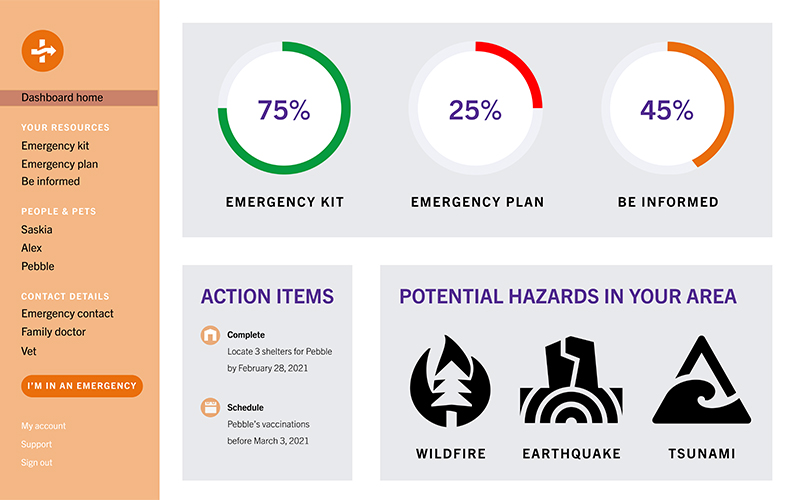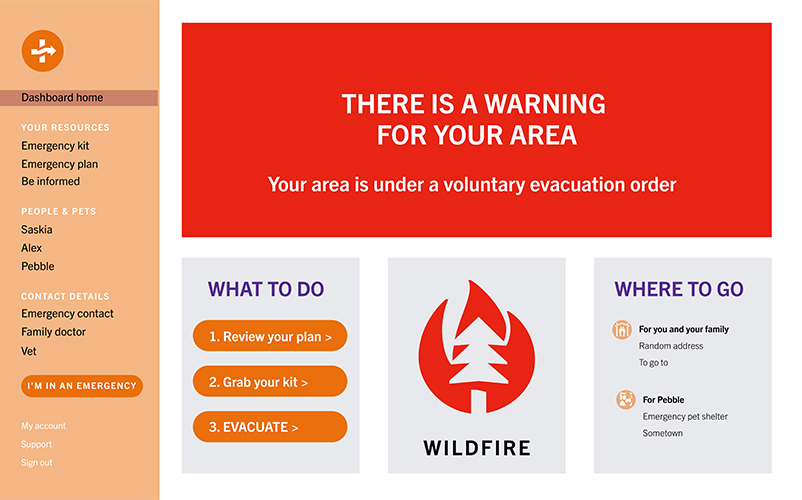Pets and other animals can act as a protective factor in an emergency if we leverage design to communicate more effectively. A new prototype website does just that.
According to the US Federal Emergency Management Agency, ‘The design of messages is critical to saving lives’.1 In emergency management, the majority of messages and instructions rely on visual design as the main framework for communication. This includes written text, which is a visual presentation of information. However, the application of basic visual communication principles and rules of legibility are frequently omitted from the emergency planning process, skillset and training. Nevertheless, the inclusion of design principles in emergency management should extend far beyond semantics and semiotics: the design of messages should start with the principles of human-centred design.
In emergency management, practitioners often speak to a ‘general public’, which only occasionally is disaggregated by demographic data (e.g. education level, income, gender or ethnicity). In contrast, design is concerned with an audience’s psychographic profile. It considers people’s aspirations, motivations, barriers and accessibility requirements. Thus, at the core of human-centred design lies empathy: the knowing, or being able to imagine, what another person or other people are thinking and/or feeling. In essence, walking in their shoes. Designers come with a rich toolkit to understand the intended audience at this deeper level.
Animals are important to people. For example, consider the bond you have with your own pet or the risks people take to save an animal, even if it is not theirs. This bond has resulted in animals (particularly pets) being considered a risk factor or effective early evacuation; if people evacuate without their pets they may subsequently return to a disaster area to care for or retrieve them or people may fail to evacuate to stay with their animals. Both activities endanger human and animal lives. However, research2 indicates that the human-animal relationship can be reconfigured into a protective factor by acknowledging its importance.

The website prototype showing a personalised and integrated human-animal disaster preparedness kit checklist. The site relies on the evidence-based Guemil icons.7
Pet owners make up two-thirds of the populations of the USA3 and Australia4, thus the ability to reconfigure animals as a protective factor has significant importance, particularly against a backdrop of an increasing frequency of disasters. A review of Orange County’s (USA) disaster preparedness information in early 20215 showed that information, particularly in relation to animals, is presented in a haphazard and disconnected manner that separates anthropocentric and zoocentric viewpoints. This stands in stark contrast to the recommendations by Thompson2, almost 10 years ago, who stated that reconfiguring animals as a protective factor requires ‘innovative communication initiatives’ that reconcile these 2 perspectives.
To address this, a prototype disaster preparedness website that integrates anthropocentric and zoocentric perspectives was presented at the Global Animals in Disaster Management Conference6 in 2021. While print remains very important as it allows for a more direct confrontation with emergency preparedness information, technologies to create responsive websites and apps are increasingly easy to use and online communication platforms have been adopted by large proportions of populations. These ‘new’ media allow for the personalisation of preparedness checklists based on a household's composition and characteristics. Thus, for example, it allows communicators to speak directly to the human-animal relationship rather than considering them individually.

The website’s dashboard showing the progress a user has made with their disaster preparedness activities, an overview of potential hazards for the user’s area and important action items.

The website’s dashboard in emergency mode (e.g. once an alert has been issued for the user’s location). It shows the action steps and refers to resources users have compiled through their previous interactions.
The protoype website integrates elements of visual communication, user interface and user experience design. In doing so, it leverages the bond people have with their animals to open up (new) ways to motivate people to prepare for disasters. The portal also provides information during and after a disaster, which are times when information acts as a structural support. To further develop this concept the next step is to test it with potential users. Theoretically, it offers improvements over current techniques but unless evidence on its effectiveness is gathered, its full potential to support comprehensive disaster preparedness for humans and animals cannot be realised.


